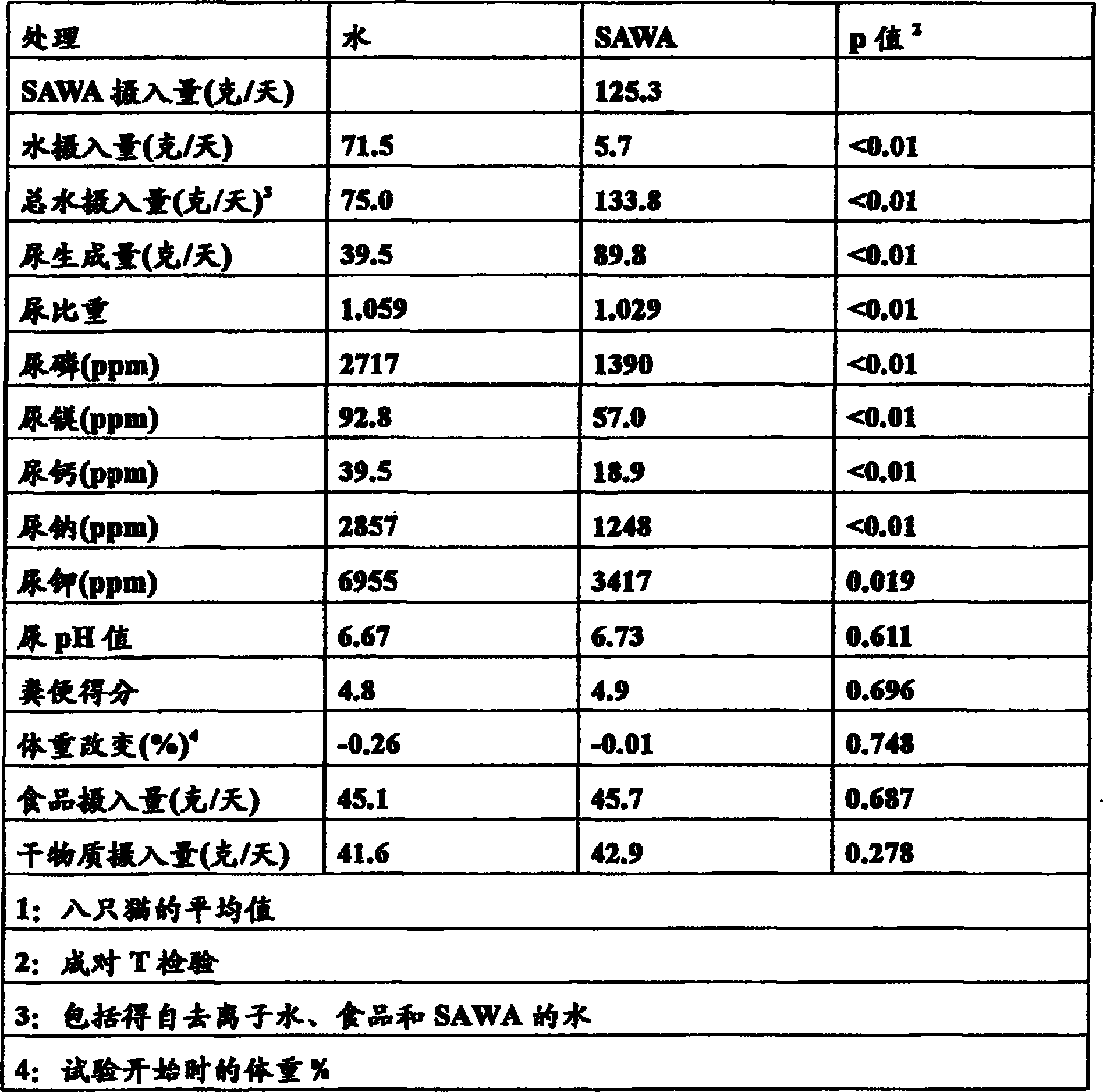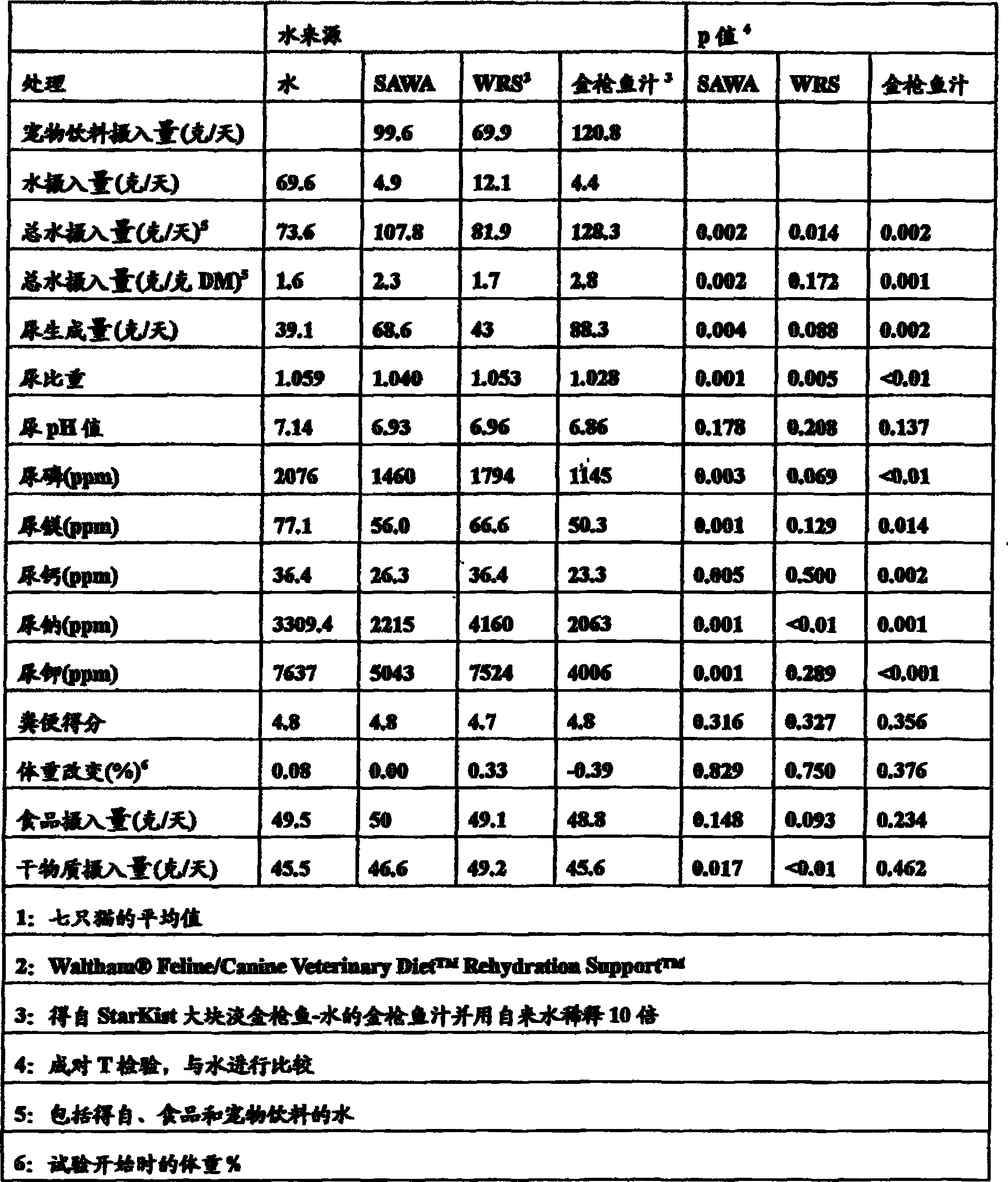Fluid composition for increased total water intake
A technology of composition and intake, applied in the direction of drug combination, application, animal feed, etc., can solve the problem of not being able to buy companion animals from the market, achieve high palatability, and increase water intake
- Summary
- Abstract
- Description
- Claims
- Application Information
AI Technical Summary
Problems solved by technology
Method used
Image
Examples
Embodiment 1
[0032] Preparation of SAWA fluid
[0033]Frozen pork livers were ground through a 1 / 8" plate. 200 lbs of ground pork livers were placed in a 300 lb capacity jug. 20 lbs of water was added to the jug and the mixture was heated to 145°F. Add 181.6g of ENZECO-AS-L (fungal protease from Enzyme Development Co.) to the mixture. Then keep the mixture at 145°F for 1 hour, then heat to 160°F. Add 181.6g of Papain 6000 (Plant Protease available from Valley Research, Inc.). The mixture was heated to 195°F and maintained at this temperature for 15 minutes. The mixture was then cooled to 100°F and filtered through a #20 mesh (US mesh). Collect The portion that passed the sieve was used as the "palatability enhancer" fraction. The palatability enhancer was then added to deionized water to form an aqueous mixture containing 5% by weight of the palatability enhancer. The deionized water and palatability enhancer The reagents were combined in an APV mixing vessel and mixed for 30 minutes. The...
Embodiment 2
[0035] cat studies
[0036] The SAWA prepared in Example 1 was tested in eight adult cats fed a commercial maintenance dry cat food. Total water intake, total urine output and urine specific gravity were measured for each study group. A crossover study design was used. The cats were randomly divided into two groups of four cats each. One group was supplied with drinking water contained in two plastic bottles, each containing about 500 g of drinking water (control group). Another group was supplied with drinking water and SAWA in two plastic bottles, one containing about 500 g of drinking water and the other containing about 500 g of SAWA (SAWA group). After two weeks, the control and SAWA groups were crossed over and treated accordingly for an additional two weeks. Water intake and urine output were measured daily during the two- and four-week study period. The total water intake of the control group was measured as the sum of water intake from drinking water and water fr...
Embodiment 3
[0042] Studies of cats using comparative products
[0043] This study compared the efficacy of SAWA from Example 1 and a commercially available product formulated and sold as a pet drink. SAWA compared to commercially available substances including Feline / Canine Veterinary Diet TM Rehydration Support TM , and from canned Brand large light tuna (light tuna) tuna juice (the balance is water). The tuna juice was diluted with water such that the nitrogen concentration of the diluted tuna juice was similar to that in SAWA.
[0044] A crossover study design similar to that in Example 2 was used. The 2 groups in Example 2 are replaced by the current 4 groups. They are control group (drinking water group), SAWA group, Feline / Canine Veterinary Diet TM Rehydration Support TM group and diluted tuna juice group. Eight cats were fed maintenance dry cat food. This test method follows the method of Example 2, replacing the SAWA of Example 2 with each product. The results of...
PUM
 Login to View More
Login to View More Abstract
Description
Claims
Application Information
 Login to View More
Login to View More - R&D
- Intellectual Property
- Life Sciences
- Materials
- Tech Scout
- Unparalleled Data Quality
- Higher Quality Content
- 60% Fewer Hallucinations
Browse by: Latest US Patents, China's latest patents, Technical Efficacy Thesaurus, Application Domain, Technology Topic, Popular Technical Reports.
© 2025 PatSnap. All rights reserved.Legal|Privacy policy|Modern Slavery Act Transparency Statement|Sitemap|About US| Contact US: help@patsnap.com



